Motorised Roller-Skates used to be on the Unusual Motorcycle page, but as I said, that was stretching the definition of a motorcycle to breaking point. I also said "When I get a moment I will set up a separate gallery for Motorised Roller Skates." and here it is, with some new material on the Mercier skates.


THE BEAUFORD MOTORISED ROLLER-SKATES
 |
| Left: Beauford Motorised Roller-Skates: 1906
This US patent is the first record of motorised roller skates, and is a relatively sophisticated design with drive to both wheels of the in-line skate. However, the drive shafts and bevel gears look far too thin and fragile.
The string 47 presumably controls the throttle, though this is currently unconfirmed. There is another control string 34 which appears to control the flow of fuel from tank 31.
|

THE CONSTANTINI MOTORISED ROLLER-SKATES
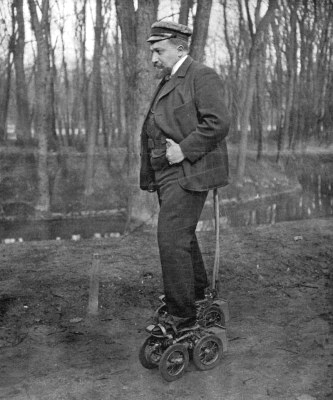 |
| Left: Constantini Motorised Roller-Skates: 1905
Constantini exhibited these IC-powered skates at the Paris Auto Show in December 1905, calling them a “Patin automobile”. The skates were 24 cm high, with solid-tired wheels 18 cm in diameter. The pair of skates weighed 12 kg. The two 4-stroke engines consumed 1.5 liters of gasoline per 100 km and gave a claimed top speed of 55 km/h. (34 mph) The prospect of such a speed on skates is intimidating, and I doubt if that was ever actually attained. Engines were not very reliable then; what happened if one skate engine failed as you were whizzing along?
The gas tank and the battery for ignition were carried on a waist-belt.
There is more info on the history of motorised skates here.
|
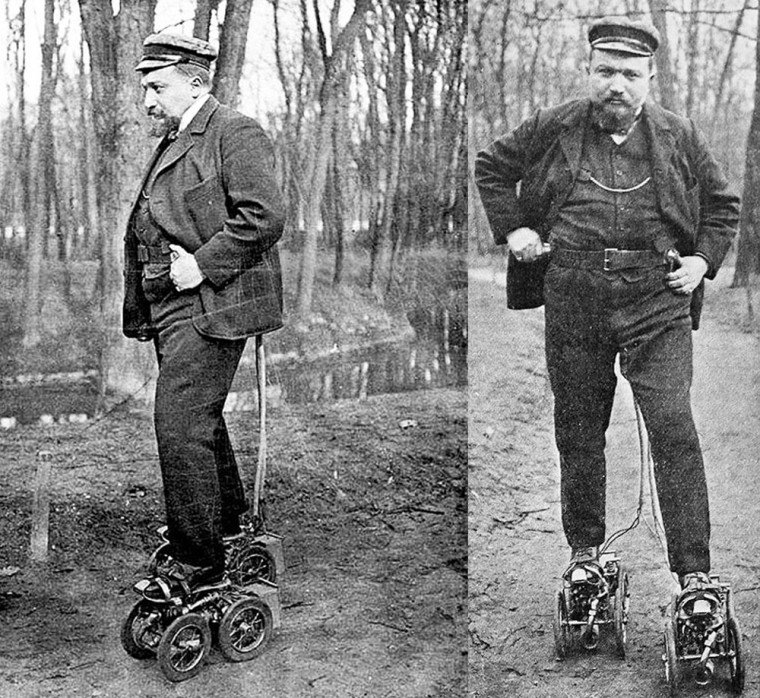 |
| Left: Constantini Motorised Roller-Skates: 1905
From Scientific American in 1906:
"In view of the fact that each skate contains a gasoline motor, carburetter, battery, and spark coil, it will be seen that the whole has been reduced to a comparatively small size. The use of the rubber-tired wheels is found to give a very smooth-running movement. On the back of each skate will be observed the small sheet-iron box which contains the battery and the spark coil. From the box a pair of wires protected by rubber tubing passes up to the leather belt which the person wears, and upon the belt is placed the switch by which he is able to make or break the ignition circuit when he wishes to start or stop the motor or to regulate its speed. On the back part of the belt is fixed a small gasoline tank in the form of a flat and slightly curved sheet-iron box"
Source: Scientific American 1906. I'm not sure I'd want a tank of petrol strapped to my back.
|
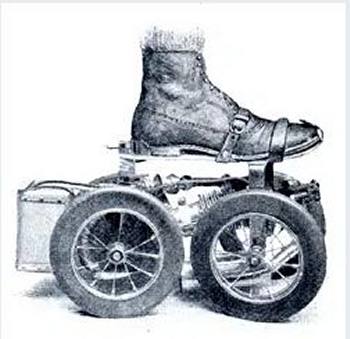 |
| Left: Constantini Motorised Roller-Skates: 1905
Unlikely as it may seem, these skates were made to be sold. The price of a pair was 450 Francs. (about 2000 € today). The then Shah of Persia ordered three pairs, so perhaps financially it was a successful project.
Here you can just see the finned cylinder of the engine between the two wheels.
|
 |
| Left: The Constantini Motorised Roller-Skate: 1917
This advertisement (Jan 4th 1917) shows that some years later Constantini was aiming at the USA market. The address on the advert is Sioux Falls, South Dakota.
Note the skates are priced at $14.95 per foot, much cheaper than those sold in 1905. 40 miles per hour? No thank you.
|

THE MERCIER MOTORISED ROLLER-SKATE
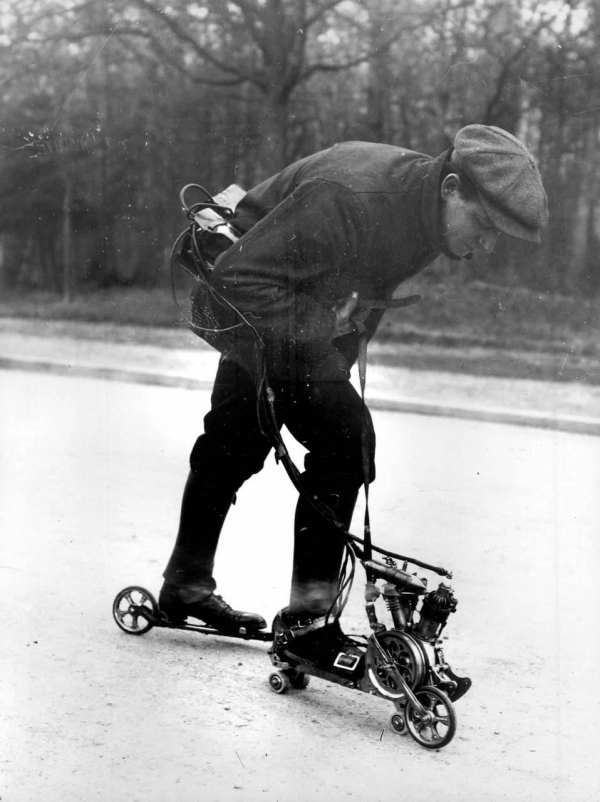 |
| Left: The Mercier Motorised Roller-Skate: 1912
One of the skates has a V-twin engine that was claimed to produce 1.25 HP. Given its tiny size, I think that figure highly doubtful. It was claimed it could take the driver 50 km at a maximum speed of 30 km/hr. Given the tiny petrol tank, I don't believe that either. It was made by a M. Mercier in 1912, who was said to have improved on the idea of the Frenchman Constantini in 1906. I'm far from sure using one skate was actually an improvement, but maybe Mercier was hoping to avoid accidents due to one skate engine failing.
At the moment it's not too clear how this was supposed to work. Only one skate is powered, so you would think the driver/rider/whatever would go round in quite small circles. The answer is presumably that the leather straps attached to the motorised skate are attached to the driver's waist, you put your best (motorised) foot forward and get a forward pull. Note that the driving wheel is at the front of the skate.
The box on the man's back carried a battery for the ignition. There was a cut-out switch for stopping the engine.
|
 |
| Left: The Mercier Motorised Roller-Skate: 1912
This is clearly a V-twin with spark ignition; there seems to be a very small sharp-ended petrol tank (to reduce wind resistance? Oh come on) feeding a very small carburettor by gravity. The carburettor can be seen between the finned cylinders,
It appears that the big wheel on the lower right is driven by friction from the engine flywheel next to it, and contacts the ground when the strap is pulled upwards, acting as a primitive clutch.
|
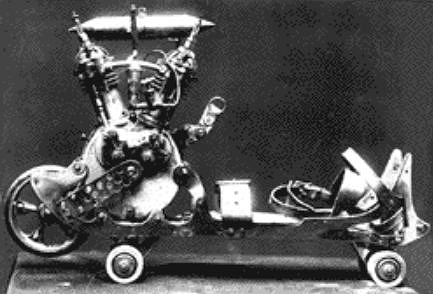 |
| Left: The Mercier Motorised Roller-Skate: 1912
This is the other side of the skate.
The induction pipes from the carburettor can be seen running to the cylinders.
|
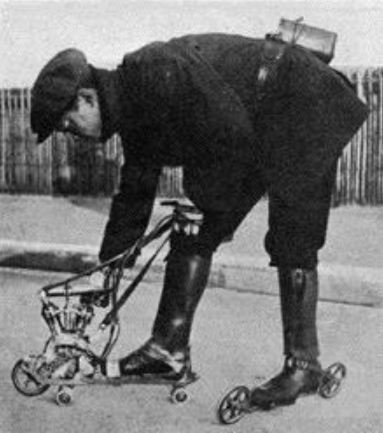 |
| Left: The Mercier Motorised Roller-Skate: 1912
A pause for adjustment.
|

THE GEBHARDT MOTORISED ROLLER-SKATE
 |
| Left: The Gebhardt Motorised Roller-Skate: 1924
One account says:
"Germany launches into motor skating. The German Hans Gebhardt, from Munich, had an original idea in 1924: he used acetylene as fuel, usually used at the time for lighting or as a heat source for torches. The skater could reach 30 km/h."
In actual fact he was anticipated by Constantini in 1905.
|
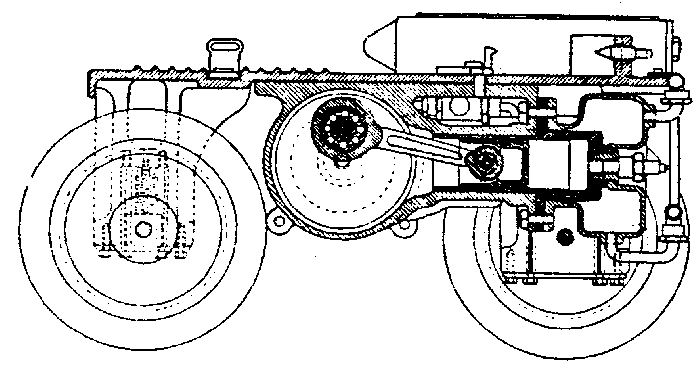 |
| Left: The Gebhardt Motorised Roller-Skate: 1924
This is a transverse section of one of the skates.
Regrettably it does not tell us much. There is no indication of how the crankshaft coupled to the rear wheels.
Presumably the acetylene was generated in the usual way as you went along, by dripping water onto calcium carbide, but there is no information as to where this happens. There is some sort of chamber around the cylinder head, but its purpose is unclear- it might be for water-cooling.
|

THE NSU MOTORSHOES
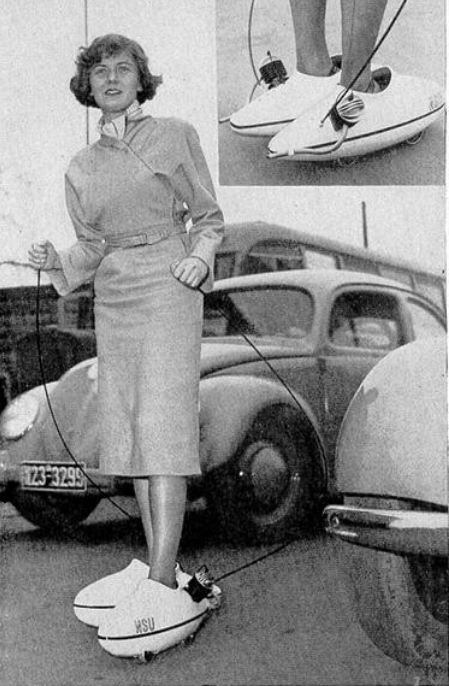 |
| Left: The NSU Motorised Shoes: 1952
There's this picture, and the date, and that's about all that is known to Google. NSU were a German motorcycle and car manufacturer, who ill-advisedly took up the Wankel engine and it did for them.
Here she stands, with what is presumably a throttle in each hand. The engines were two-stroke, with a capacity of 24 cc each. It looks as though the shoes have four small wheels. This setup could apparently whizz along at 16 mph if you were brave enough.
The Volkswagen and its number plate suggest the photo was taken in Germany. Presumably some sort of publicity stunt.
Source: Unknown magazine
|
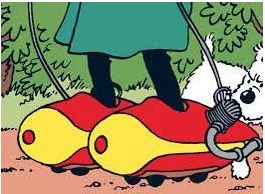 |
| Left: Fictional Motorised Shoes: 1958
These are the motorised shoes of Professor Calculus, a character in the Tintin cartoon books. Clearly a straight copy from the photo above.
The dog is called Snowy.
Source: It has not been confirmed, but it is believed that this image comes from the Tintin book The Red Sea Sharks on page 61. This was originally published in French in 1958 so the timing is appropriate.
|

THE MOTORIZED ROLLER SKATE COMPANY OF DETROIT
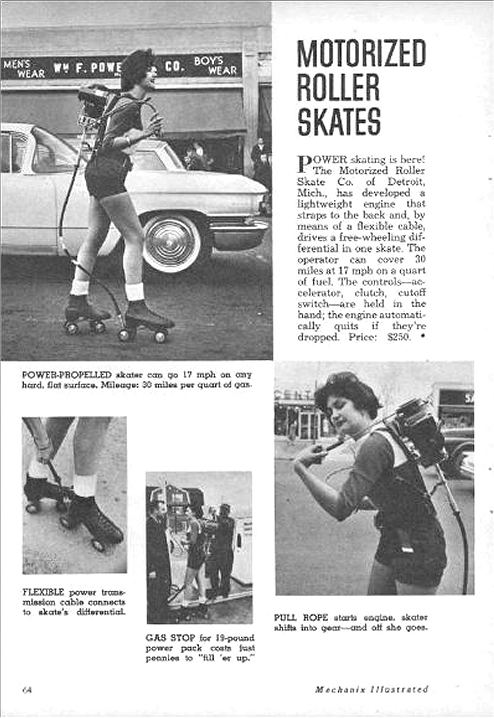 |
| Left: Motorised Skates: 1956
These are believed to be the motorised skates produced by the Motorized Roller Skate Company of Detroit, beginning in 1956. The engine strapped to your back weighed 19 pounds (including one quart of gasoline) and there were no brakes, despite a claim that the skates could reach speeds up to 17 mph. Braking on skates is a tricky business because a modest application could land you on your nose. Only one skate was powered so it was placed in front to pull you along. Having the powered skate trailing would probably have given unstable steering.
The Motorized Skate Company of Detroit was founded in 1955 by an inventor from Lincoln Park, Michigan named Antonio Pirrello. He obtained US patent 2,857,008 for the skates in 1958.
A pair of these skates cost $250 in 1956, something like $2300 in today’s money; clearly a toy for the rich. And the brave. And the foolish.
Source: Mechanix Illustrated, 1956
|
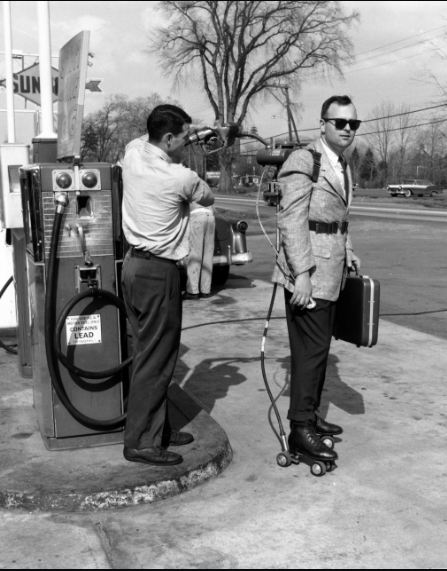 |
| Left: Motorised Skates: 1961
The original picture caption read:
"11th May 1961: Salesman Mike Drechsler has his motorised roller skates refuelled at a petrol station near Hartford, Connecticut. He has a single horsepower air-cooled engine strapped to his back and holds a clutch, accelerator and engine cut-off switch in his hand."
These skates are from the Motorized Roller Skate Company again. Drechsler was rsponsible for the pictures shown above, which used a model in NYC.
There is a great deal more info on here.
|

V8-POWERED GIANT SKATE
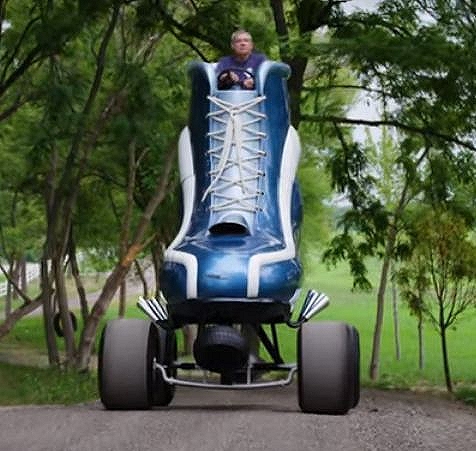 |
| Left: V8-powered Giant Skate: 1992
Yes, that's real, not Photoshop. This skate is powered by a 5.7-liter Chevy V8, which drives a solid rear axle via an automatic transmission and a chain. It is 14-feet tall but only 13-feet long, and with a short wheelbase and high C of G, it is clearly not the most stable vehicle on the planet. Top speed is said to be around 20 mph. The body is fibreglass.
It was built by Jay Ohrberg in the early 90's. He is also known for having built a 24-wheel limousine, and many other bizarre vehicles.
You can see a video of it running here.
|

RUSSIAN PISTON BOOTS
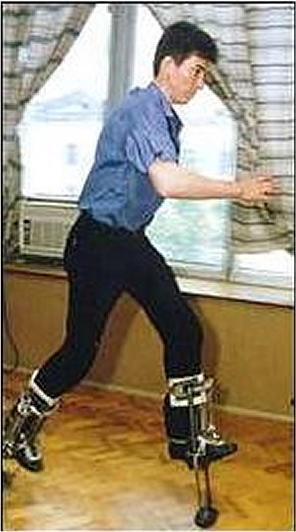 |
| Left: Petrol-powered Piston Boots: 2000
This modern take on seven-league boots comprises petrol-powered boots invented by Russian aeroplane engineer Roman Kunikov. Not strictly motorised skates, but I don't foresee an entire Gallery on this technology appearing. I could be wrong.
The picture is from a BBC article in 2000; this is the text:
"PETROL-POWERED BOOT LIFTS OFF"
"A Russian aeroplane engineer has designed petrol-powered boots which boost running speeds beyond that of Olympic sprinters.
Roman Kunikov says his fancy footwear will give people a flying start, propelling them as much as four metres (13 feet) per step. The boots were tested on Tuesday in a public square in Ufa, a town 1,200 kilometres (750 miles) southeast of Moscow. Professor Kunikov believes that, as well as being fun, the shoes could be used by rescue services to reach quickly areas inaccessible to vehicles with wheels."
"The boots are powered by 30-cm (12-inch) pistons strapped to the calf. They fire when the wearer steps down, pushing a metal platform away from the bottom of the shoe. This shoots the wearer up into the air. The metal plate is connected to the sole of the shoe by springs, so it snaps back into place after each step. The shoes weigh about one kilogram (2.2 pounds) each, and include a fuel tank holding 1.4 ounces of petrol, a tiny carburettor, and a spark plug together with associated wires and pipes. The carburettor can be adjusted to take account of different people's weights."
Each boot has its own engine. The fuel lasts for about 25 minutes, Professor Kunikov said, and there have not been any accidents so far. He is at the Ufa Aviation Technical University which used to work on defence contracts for the Soviet Union, including design projects for the MiG fighter jets. But when defence budgets dried up after the 1991 Soviet collapse, the university, like hundreds of factories and institutes across Russia, began looking for ideas with value in a capitalist economy."
Source: The BBC.
|
No mention of this idea at later dates has been found, and it appears to have sunk without trace, which is probably just as well.

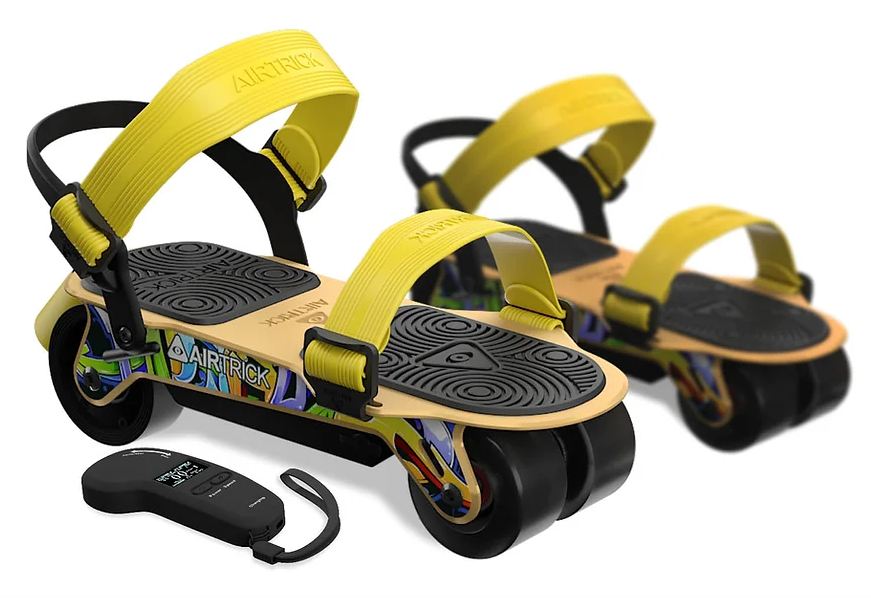 |
| Left: Airtrick Electric-powered Skates: now
Motorised roller skates are still very much with us, as a minority interest, but now they are electrically powered. There are many on the market, and the Airtrick A1-Ultra shown here is only one example. Claimed top speed is 20 mph, with a 15 mile range. Maximum power is 360 Watts, about half a horsepower. Impressive!
Now you control the skates with a remote instead of a cable.
Pity about the depth-of-field in the photo.
See the Airtrick website here.
|

























